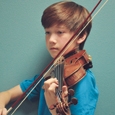Playing fast sections is often a struggle for young violin and viola players. They find that the left-hand fingers do not locate their places on the strings quickly or accurately, and the bow gets tangled up and unable to play effectively. Things quickly devolve into a jumbled mess. Violinists can learn to play faster by using small muscle groups and economical movements to avoid excess motion.
Left-Hand Efficiency
1. Left-hand fingers should be kept close to the string. Many young players let the third and fourth fingers curl into the hand or fly away from the fingerboard. In fast passages this means that they are not in the right place, ready to go when they are needed. Work on left-hand efficiency by placing the first finger on the string and leaving it down while tapping the second or third fingers on the fingerboard. Look for places where the first finger can stay rooted on the string while the other fingers play patterns. Practice trills between the first and second finger, keeping the second finger close to the fingerboard.
2. Set up as many fingers as possible before starting a passage. If a phrase starts with the third or fourth finger, have the index finger prepared to go down on the string at the same time. This improves intonation and creates a stable hand frame. Scan each passage for fingering challenges: fourth-finger extensions, augmented seconds, or half-steps. Position the hand for the most difficult aspect of a phrase. The knuckles of the hand should be parallel to the fingerboard, allowing the fingers to hover just above the strings.
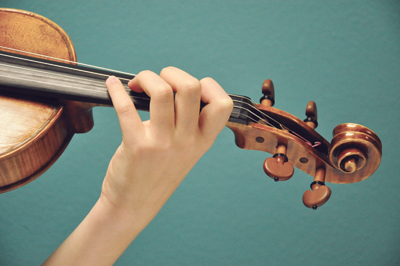
3. To shift at a fast tempo, students should prepare by bringing the elbow around the instrument. Fingertips should release immediately before a shift. To practice this release, have students place the third finger in first position on D natural on the A string. Play a solid note for half of a bow and then switch to a natural harmonic. When students feel this lighter harmonic touch in the fingertip, they can shift up to third position. Then allow the third finger to fall into the string to create the pitch F sharp.
Right-Hand (Bow) Efficiency
1. For faster notes, students should use less bow and avoid big arm movements. Have them lean the upper right arm against a wall and articulate short strokes in the middle of the bow. Once the upper arm and elbow are stable, the hand can move independently.
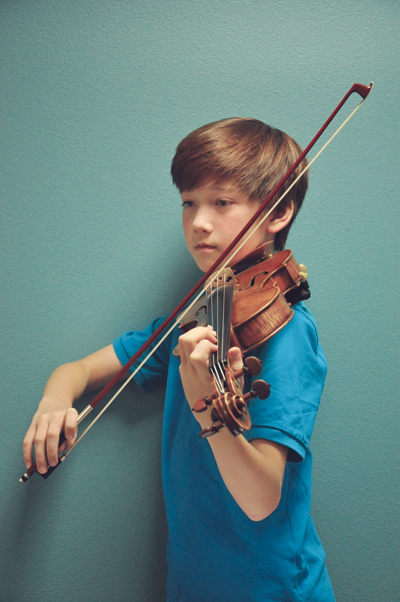
2. To work on efficient string crossings, place the bow on a string and then move the bow from string to string without making a sound. Set the elbow at the D string level and practice pivoting from the highest to lowest string using only the hand.
Once players are able to play efficiently at a slow tempo, there are many practice techniques to help them learn to do it fast.
Practicing
1. Three-speed practice is a valuable method for increasing fluency. Take a simple left-hand pattern and play it twice in quarter notes, four times in eighth notes, and eight times in sixteenth-notes.
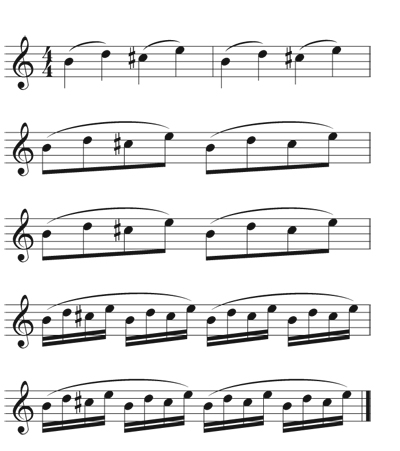
During the quarter note version, players can concentrate on left-hand efficiency, making sure that the first finger is held down throughout. The eighth-note version allows players to find the flow of the pattern, while the sixteenth-note version challenges coordination. Three-speed practice can also be applied to longer phrases. Find a slow tempo where a passage can be played without mistakes. A medium tempo develops a sense of line and a fast tempo reveals technical inefficiencies.
2. A moveable fermata can be inserted into fast passages as a practice tool. In the following example the moveable fermata is placed on the first note of each group of sixteenths.

The fermata should last one quarter plus one sixteenth note so that the exercise can be played with a metronome. During the fermata, students scan ahead and plan the next three notes. After practicing with the fermata on the first note of each group, move it to the second, third, or fourth note. Advanced players can move the fermata around for each group.

3. Practicing in small groups or chunks is a great way to learn music quickly. In the next example a rest is placed between each group of four sixteenth notes. During the rest, scan the next group and prepare the left-hand accordingly.
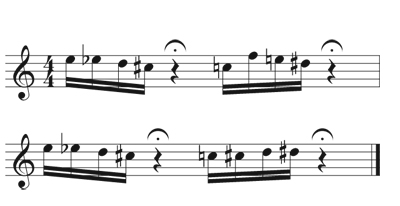
Practicing in groups combines mental preparation with physical drill. Practice each group at least two times, trying to make the second execution clearer and more efficient than the first. Also try to play each group faster than the goal tempo. Practicing faster than the desired tempo makes the goal tempo feel effortless. To work on putting the chunks together, add a note to the end of each group. This overlap exercise drills continuity and flow between the beats.
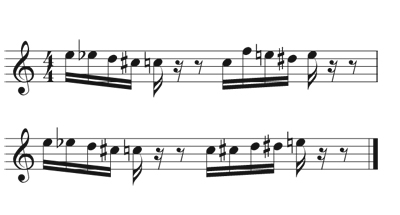
This type of exercise drills continuity between the beats. When practicing in groups, play each passage separate bows and slurred.
4. Part of learning to play fast is mental preparation. Without the instrument, have students sit down with a score and scan through a piece imagining playing it quickly. They should try to hear the pitches in their heads and feel the motions in the arms without actually moving. The goal is to stop reading every note and sense patterns and overall shapes instead. Then put on a recording and have students practice the piece without the instrument, miming the playing technique. It is also helpful to have music partly or fully memorized when trying to play fast.
Playing fast in orchestra requires the same type of efficiency as solo playing. Remind string sections to use efficient left- and right-hand movements. Students should use less bow for short notes and play in the same part of the bow as the rest of the section.
Three-speed and chunking practice can also be used as rehearsal techniques for ensembles. Through the organization of movement and creative practice, players will learn to experience the joys of playing fast.
